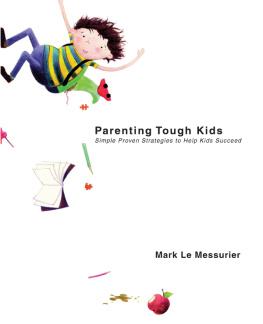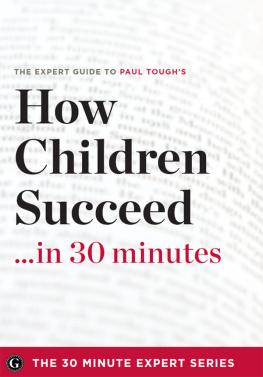Paul Tough - Helping Children Succeed: What Works and Why
Here you can read online Paul Tough - Helping Children Succeed: What Works and Why full text of the book (entire story) in english for free. Download pdf and epub, get meaning, cover and reviews about this ebook. year: 2016, publisher: Houghton Mifflin, genre: Home and family. Description of the work, (preface) as well as reviews are available. Best literature library LitArk.com created for fans of good reading and offers a wide selection of genres:
Romance novel
Science fiction
Adventure
Detective
Science
History
Home and family
Prose
Art
Politics
Computer
Non-fiction
Religion
Business
Children
Humor
Choose a favorite category and find really read worthwhile books. Enjoy immersion in the world of imagination, feel the emotions of the characters or learn something new for yourself, make an fascinating discovery.

- Book:Helping Children Succeed: What Works and Why
- Author:
- Publisher:Houghton Mifflin
- Genre:
- Year:2016
- Rating:5 / 5
- Favourites:Add to favourites
- Your mark:
- 100
- 1
- 2
- 3
- 4
- 5
Helping Children Succeed: What Works and Why: summary, description and annotation
We offer to read an annotation, description, summary or preface (depends on what the author of the book "Helping Children Succeed: What Works and Why" wrote himself). If you haven't found the necessary information about the book — write in the comments, we will try to find it.
Helping Children Succeed: What Works and Why — read online for free the complete book (whole text) full work
Below is the text of the book, divided by pages. System saving the place of the last page read, allows you to conveniently read the book "Helping Children Succeed: What Works and Why" online for free, without having to search again every time where you left off. Put a bookmark, and you can go to the page where you finished reading at any time.
Font size:
Interval:
Bookmark:

Why do poor children struggle in school?the importance of noncognitive skillsO.K., now that we know this, what do we do?
The problem with scaling updifferent approaches, common threadsan unbroken story from birth through high school.
Can we agree on the best way to teach grit?teaching character without talking about characteris teaching the right word to use?
A brief explanation of our fight-or-flight responsewhat toxic stress does to the brainwhy executive functions matter in school.
How babies make sense of the worldthe importance of serve and returnhelping infants handle stress (or not).
What is your ACE score?adverse experiences vs. adverse environmentsACEs and their effect on school success.
The good kind of neglect?the harsh effects of chronic understimulationa lesson from a Russian orphanage.
Why the early years mattereducation funding meets brain sciencebaby talk and the policy makers dilemma.
What a Jamaican study can teach us about parental attachmentbuilding a secure basecan we just hand out brochures and let parents figure it out from there?
Attachment and Biobehavioral Catch-upJulianna and the cookie-throwing incidentWe just zero in on this one positive moment.
The Educare effectreaching informal childcare providershelping pre-K teachers feel less stressed-outthe bi-directional model of self-regulation.
What changes (and what doesnt) in kindergartenit may not be a matter of you just not sucking it up enoughthe deep roots of perseverance and resilience.
The history of zero tolerancewho gets suspended and whythe effects of suspensions on the kids who arent suspendedwhy harsh punishments often backfire.
The behaviorist approach to educationgetting past stickers and pizza partiesThe impact of financial incentives on student achievement is statistically 0.
Intrinsic vs. extrinsic motivationwhat makes a 4-year-old want to quit crayoning?anatomy, competence, and relatedness.
How do we measure noncognitive abilities?finding the educators who help kids engagewhat are the deep messages teachers convey to their students?
The narrative of failure within each schoolwhat kind of classroom promotes perseverance?be gritty, or just act gritty?
Is my teacher a friend or a foe?the transformative power of a Post-itswitching off the fight-or-flight alarm.
Why Rashid got jumped, and why he was able to talk about ithow classroom climate affects test scoresis it really possible to transform an entire school?
What happens when teachers give up the reins?self-directed projects and student-led conferencesassigning work that is challenging, rigorous, and deep.
Lots of basic skills, little problem-solvingthe Japanese approachthe dominant American instructional strategyConfusion and frustration should be minimized.
The demands of the 21st-century job marketDeeper learning has historically been the province of the advantagedchange comes to Elm City Prep.
Seven million children in deep povertya broken systemchanging our policies, our practices, and our way of thinking.
All rights reserved
For information about permission to reproduce selections from this book, write to or to Permissions, Houghton Mifflin Harcourt Publishing Company, 3 Park Avenue, 19th Floor, New York, New York 10016.
www.hmhco.com
Library of Congress Cataloging-in-Publication Data is available.
ISBN 978-0-544-93528-0
e ISBN 978-0-544-93531-0
v1.0516
Book design by Dylan Rosal Greif
Cover design by Chelsea Cardinal
For Charles, who is just getting started
In 2013, the United States reached an educational milestone. For the first time, a majority of the countrys public school students51 percent of them, to be precisefell below the federal governments threshold for being low income, meaning they were eligible for a free or subsidized school lunch. This wasnt an overnight development; according to data compiled by the Southern Education Foundation, the percentage of American public school students who are low income has been rising steadily since the foundation started tracking the number in 1989. (Back then fewer than a third of students met the definition.) Passing the 50 percent mark may be a symbolic distinction, but as symbols go it is an important one. It means that the challenge of teaching low-income children can no longer be considered a side issue in American education. Helping poor kids succeed is now, by definition, the central mission of American public schools and, by extension, a central responsibility of the American public.
It is a responsibility we are failing to meet. According to statistics from the U.S. Department of Education, the gap in eighth-grade reading and math test scores between low-income students and their wealthier peers hasnt shrunk at all over the past 20 years. (The gap between poor and wealthier fourth-grade students narrowed during those two decades, but only by a tiny amount.) Meanwhile, the difference between the SAT scores of wealthy and poor high school seniors has actually increased over the past 30 years, from a 90-point gap (on an 800-point scale) in the 1980s to a 125-point gap today. The disparity in college-attainment rates between affluent and low-income students has also risen sharply. And these days, unless children from poor families get a college degree, their economic mobility is severely restricted: Young people who grow up in families in the lowest income quintile (with household income below about $21,500) and dont obtain a B.A. now have just a one in two chance of escaping that bottom economic bracket as adults.
These disparities are growing despite the fact that over the past two decades, closing the test-score gaps between affluent and poor children has been a central aim of national education policy, as embodied in President George W. Bushs No Child Left Behind law and President Barack Obamas Race to the Top program. These government efforts have been supported and supplemented by a constellation of nonprofit groups, often backed by philanthropists with deep pockets and an abiding commitment to addressing educational inequality. Along the way, certainly, those efforts have produced individual successesschools and programs that make a genuine difference for some low-income studentsbut they have led to little or no improvement in the performance of low-income children as a whole.
The ongoing national discussion over how to close those gaps, and whether they even can be closed at all, has not been confined to policy makers and philanthropists. Educators across the country are intimately familiar with the struggles of children experiencing adversity, as are social workers, mentors, pediatricians, and parents. If you work with kids who are growing up in poverty or other adverse circumstances, you know that they can be difficult for teachers and other professionals to reach, hard to motivate, hard to calm down, hard to connect with. Many educators have been able to overcome these barriers (with some of their students, at least). But Ive spoken with hundreds more in recent years who feel burned out by, even desperate over, the frustrations of their work.
Those of us who seek to overcome these educational disparities face many obstaclessome financial, some political, and some bureaucratic. But the first obstacle, I would argue, is conceptual: We dont yet entirely understand the mechanisms behind childhood adversity. What is it about growing up in poverty that leads to so many troubling outcomes? Or to put the question another way: What is it that growing up in affluence provides to children that growing up in poverty does not?
Font size:
Interval:
Bookmark:
Similar books «Helping Children Succeed: What Works and Why»
Look at similar books to Helping Children Succeed: What Works and Why. We have selected literature similar in name and meaning in the hope of providing readers with more options to find new, interesting, not yet read works.
Discussion, reviews of the book Helping Children Succeed: What Works and Why and just readers' own opinions. Leave your comments, write what you think about the work, its meaning or the main characters. Specify what exactly you liked and what you didn't like, and why you think so.













